ISSN 2348-1218 (print)
International Journal of Interdisciplinary Research and Innovations ISSN 2348-1226 (online) Vol. 10, Issue 2, pp: (61-76), Month: April - June 2022, Available at: www.researchpublish.com

ISSN 2348-1218 (print)
International Journal of Interdisciplinary Research and Innovations ISSN 2348-1226 (online) Vol. 10, Issue 2, pp: (61-76), Month: April - June 2022, Available at: www.researchpublish.com
Subhagata Chattopadhyay1*, Rupam Das1
1 Department of Research and Development (Digital Health), Acculi Labs Pvt. Ltd., Bangalore 560098, Karnataka, India
*Corresponding Author information: Subhagata Chattopadhyay Clinical Head, Department of Research and Development (Digital Health) Acculi Labs Pvt. Ltd. Bangalore 560098, Karnataka, India DOI: https://doi.org/10.5281/zenodo.6631413
Published Date: 10-June-2022
Abstract: Mind-heart-body is tightly intertwined. Anxiety is one of the most prevalent mental health issues during the COVID pandemic. Lyfas is a smartphone-based biomarker instrument that has been used as a CovidAnxiety Detector (LAD) where SD2/SD1 has been considered the key optical biomarker of anxiety and its other adverse health consequences. The objective of this study is to validate the efficacy of LAD with that of two gold-standard anxiety rating instruments – (i) 7-item Generalized Anxiety Disorder (GAD-7) and (ii) 14-item Hamilton Anxiety Rating Scale (HAM-A). A total of 1454 Indian adults (Male 955, Female 499) within the age group of 18-87 years (median and average age of 39.56 and 37 years respectively), divided into three age groups: 18-30 years, 31-50 years, and >50 years who were RTPCR positive took (i) GAD-7, (ii) HAM-A, and (iii) Lyfas tests daily till they became RTPCR negative (average span of 14 days). Internal consistency (α), Spearman’s rank correlation (r), Classification metric - sensitivity, specificity, precision, accuracy, fscore, and Youden’s index of LAD has been computed and finally, the inter-rater reliability between (a) LAD and GAD-7 and (b) LAD and HAM-A is measured with Bland-Altman Reliability Assessment. LAD shows high inter-rater reliability (i.e., the minimum proportional bias) around the mean difference with the Bland-Altman test, good-to-excellent internal consistency (>0.8 and >0.9, respectively), and high correlations (r>0.6) of LAD with GAD-7 and HAM-A in the 18-30 years age group. LAD shows high average accuracy (0.9953 and 0.9764 in males and females respectively), precision (>0.9), and Youden’s index (0.9976 and 0.8633), for males and females. Hence, LAD is a reliable and novel smartphonebased non-invasive and ubiquitous biomarker clinical instrument to screen and monitor GAD and its adverse consequences such as sudden cardiac death and suicide in adults, especially in the ongoing pandemic situations.
Keywords: COVID-19, Lyfas CovidAnxiety Detector, Generalized Anxiety Disorder, Hamilton Anxiety rating scale, Sudden cardiac death, Suicide.
GAD comes under neurotic disorder along with phobia and is the most common mental health issue globally with a prevalence rate of 5.8% in the Indian population (1). Here, irrespective of any untoward incidence, patients feel extreme threat and apprehension of catastrophe, which is uncontrollable and thus abruptly brings down the quality of life. Researchers have found that GAD has certain types of personality traits (endophenotype of pathological worries, neuroticism, and frightfulness due to uncertainties) and hence genetic linkage, such as 5-HTT, 5-HT1A, BDNF, MAOA known as ‘the anxious gene’ (2) along with the neurochemicals has given it multilevel pathophysiological cascading
ISSN 2348-1218 (print)
International Journal of Interdisciplinary Research and Innovations ISSN 2348-1226 (online)
Vol. 10, Issue 2, pp: (61-76), Month: April - June 2022, Available at: www.researchpublish.com
effects in the neurocognitive process of the brain (3), where the connections between the prefrontal cortex and amygdala are distorted leading to amygdala-driven fight or flight reactive behavior to even a trivial stimulus and very less cognitive involvement in rationalizing (4) There are silent traits as well, as the authors envisage and such traits are unveiled when any environmental challenge is faced, which has happened during the COVID pandemic (5) It is pertinent to state that Ttype Ca++ channels (low-voltage-activated Ca++ channels are highly expressed in the stress-responsive regions of the brain and thus modulate the generalized anxiety states (6) Such deep-rooted pathophysiology proves why anxiety disorders are not only the commonest neurotic disorder but also are obstinate types, clinically.
As the mind-heart-body is tightly interlinked, GAD has several adverse health outcomes in the form of cardiometabolic (7) (8) and mental (9). During the pandemic time, such risks are quite high.
To address the challenges in catering to healthcare facilities during a pandemic-induced lockdown of nearly 12 weeks, Govt. of India legalized telemedicine with certain protocols, rolled-out for its safe practice, with a special note on protecting the privacy of the patients' data (10). Mobile health (mHealth), such as Lyfas took a few steps ahead to detect the mind-body homeostasis of the body with its AI-ML-based analytics and visualization, abreast protecting patients’ privacy (11). Just by pressing the index finger on the rear main camera of the smartphone the help-seekers, using the arterial photoplethysmography (APPG) (12) and photochromatography (PCG) methods, can capture several optical biomarkers that surrogate for the cardiovascular autonomic modulation, which occurs due to ‘errors’ in the physiological processes that maintain the mind-body homeostasis. Lyfas application has been pre-installed in patients’ smartphones and with a multilingual voice-assisted prompt, the test takers can easily complete the test and generate the analytics report with meaningful graphical representations of their mind-body state, which can be evaluated by the trained doctors to provide medical management support during the pandemic period. It is worth mentioning that recently Lyfas has been applied to screen sub-clinical depression with its further effects in generating negative thoughts and insomnia (13) It is, therefore hypothesized that Lyfas poses to be a useful instrument to evaluate the mental state of the test-takers by assessing their sympathovagal balance by examining the optical biomarker scores (SD1/SD2), which have been then corroborated with the history of the test-takers and during the series of average ten counseling sessions per GAD patient
The objective of this work is to validate the reliability of Lyfas as a GAD detecting instrument to two well-acclaimed gold standard tools, such as (i) Generalized Anxiety Disorder (GAD-7) (14) and (ii) Hamilton Anxiety Rating Scales (HAMA) (15)
a. The study protocol was approved by the Vagas Institutional Ethics Committee review board (No. ECR/1181/Inst/KA 2019, dated 30-01-2020).
b. Signed informed consents of all participants’ have been taken according to the declaration of Helsinki by the research team prior test.
An IoT-enabled online platform has been created for visitors who want to take anxiety tests (16). The platform provides health information related to anxiety disorders in line with the Diagnostic and Statistical Manual (DSM)-V version (17)
A total of 1454 Indian adult participants (Male 955, Female 499) within the age group of 18-87 years (median age 37 and average age 39.56 years), divided into three groups: 18-30 (Male: 342, Female: 176); 31-50 (Male: 406, Female: 195), and >50 years (Male: 207, Female 128) who were RTPCR positive and home-quarantined All are drug-naïve, i.e., not under any anxiolytics or selective serotonin reuptake inhibitor (SSRI), or other mood elevators Lyfas tests were taken thrice daily till they became RTPCR negative with an average monitoring period of 14 days. None of them have been hospitalized or developed any acute symptoms
The study hypothesizes that ‘anxiety’ is a common state of human emotion (18), with an estimated global prevalence rate of 7.3% in the population (19). People having its trait develop the ‘disorder’ with time and for no obvious or any specific
ISSN 2348-1218 (print)
International Journal of Interdisciplinary Research and Innovations ISSN 2348-1226 (online) Vol. 10, Issue 2, pp: (61-76), Month: April - June 2022, Available at: www.researchpublish.com
reason, they suffer from a high grade of anxiety, which has been evident during the COVID period, especially during the roll-out of the vaccination process (20). This population is over-apprehensive about anything and always thinks of some forms of imminent disaster that may occur in their lives at any time (21) On the other hand, people who do not have such a trait are not found worried at all and adapted to it (19) Thus, to capture the population with that trait (as COVID might have unmasked it) and to get a more holistic picture of growing generalized anxiety in the population, COVID-specific anxiety scales or instruments are not considered in the study as these might restrict the context. In other words, the authors have used COVID as a measure to unveil the generalized anxiety disorder trait in the vulnerable population.
A systematic search has been conducted to learn about several available anxiety rating scales in Psychiatry.org, Google Scholar, Medline, Medscape, Pubmed, and PsychInfo using the keywords such as anxiety rating scale, anxiety tool, anxiety instrument, and gold standard anxiety rating tools. Among 25 scales and 529 items, two gold standard and wellacclaimed instruments, such as a (i) 7-item Generalized Anxiety Disorder (GAD-7) (14) and the (ii) 14-item Hamilton Anxiety Rating Scale (HAM-A) (15) have been chosen, based on the advice of three senior psychiatrists who has handson experience in using these rating scales since years of their practicing life
GAD-7 and HAM-A: Two well-acclaimed instruments (14) (15)
GAD-7 is a well-acclaimed popular self-administered instrument to screen and grade GAD in adults. It explores the anxiety state over the past two weeks by asking 7 questions, each having a 4-point rating. Based on the threshold score of 10, GAD-7 has 89% sensitivity and 82% specificity. Apart from GAD, it can screen for three other most common mental illnesses, such as panic disorder (74% sensitivity and 81% specificity), social anxiety disorder (72% sensitivity and 80% specificity), and post-traumatic stress disorder (66% sensitivity and 81% specificity) in adults (22).
HAM-A is an anxiety rating scale for children, adolescents, adults, and elderlies and is one of the earliest scales available for clinical practice and trials (research). It consists of 14-items to capture the rate (0-4 points) of psychic i.e., mental agitation and psychological distress, and somatic i.e., the physical effects of those psychic conditions. The advantage of HAM-A is that it is a well-acclaimed gold standard GAD rating instrument with an administration time of 10-15 minutes with a high degree of inter-rater reliability. The disadvantage of this rating instrument is that it is poor in differentiating the somatic anxiety vs somatic side effects of antidepressive and anxiolytic drugs and does not possess any standardized probe question.
Lyfas CovidAnxiety Detector (LAD): A novel smartphone-based biomarker instrument Lyfas is a commercially available smartphone-based biomarker instrument that utilizes the principle of arterial photoplethysmography (APPG) (23). From the index finger capillary when the finger is gently kept on the rear main camera of the smartphone with the LED light ‘ON’, Lyfas, using its proprietary algorithm, captures the pulse rate variability (PRV) that surrogates for the heart rate variability (HRV) and its correlated optical biomarkers, which in turn refers to the state of cardiovascular autonomic modulation in maintaining the mind-body homeostasis (23) Lyfas measures the short HRV (120 seconds) and has been validated against Polar H10 gold standard biomedical instrument with 79% and 81% of Youden’s indices in males and females, respectively (24), and 93.53% inter-rater reliability on Bland-Altman’s test (25) It has also been stringently tested for its circadian hypersensitivity and found to be not hypersensitive and therefore can be called robust (26) The SD2/SD1 HRV optical biomarker score refers to the level of anxiety in a population that Lyfas captures alongside other PRV correlates. Chronic anxiety results in sympathetic hyperactivity through Multiunit Efferent Muscle Sympathetic Nerve Activity (MSNA) (27), which is echoed in the PRV, and the SD2/SD1 scores are the crucial optical biomarkers that quantify the extent of sympathovagal balance, where a higher value of the ratio argues for the sympathetic dominance (23). SD1 measures the diastolic blood pressure, the difference between the maximum and minimum heart rate, and other optical biomarkers such as RMSSD, pNN50, SDNN, the power in the LF and HF bands, and total power during a short-term recording of 120 seconds as mentioned before (28). On the other hand, SD2 measures short and long-term HRV in milliseconds and correlates it with the LF power and Baroreflex sensitivity (28). Baroreflex stimulates shared responses of the autonomic nervous system. When the afferent Baroreflex traffic increases blood pressure is raised, the efferent sympathetic traffic decreases, and as a result, the efferent parasympathetic traffic increases (29). The SD2/SD1 ratio, therefore, measures the mutability of the R-R time series and hence the sympathovagal balance during the stage of sympathetic activation (30), which happens during anxiety (see Fig. 1). Thus, in this work, SD2/SD1 score-based LAD) is a novel approach, which has been used during the lockdown period when the mobility of the population has been restricted as per the rate of occurrence of the infection. It is also worth
ISSN 2348-1218 (print)
International Journal of Interdisciplinary Research and Innovations ISSN 2348-1226 (online) Vol. 10, Issue 2, pp: (61-76), Month: April - June 2022, Available at: www.researchpublish.com
noting that LAD is a robust instrument and hence is not hypersensitive to diurnal physiological changes. Table 1 presents the comparative study of LAD, GAD-7, and HAM-A.
(a) (b)
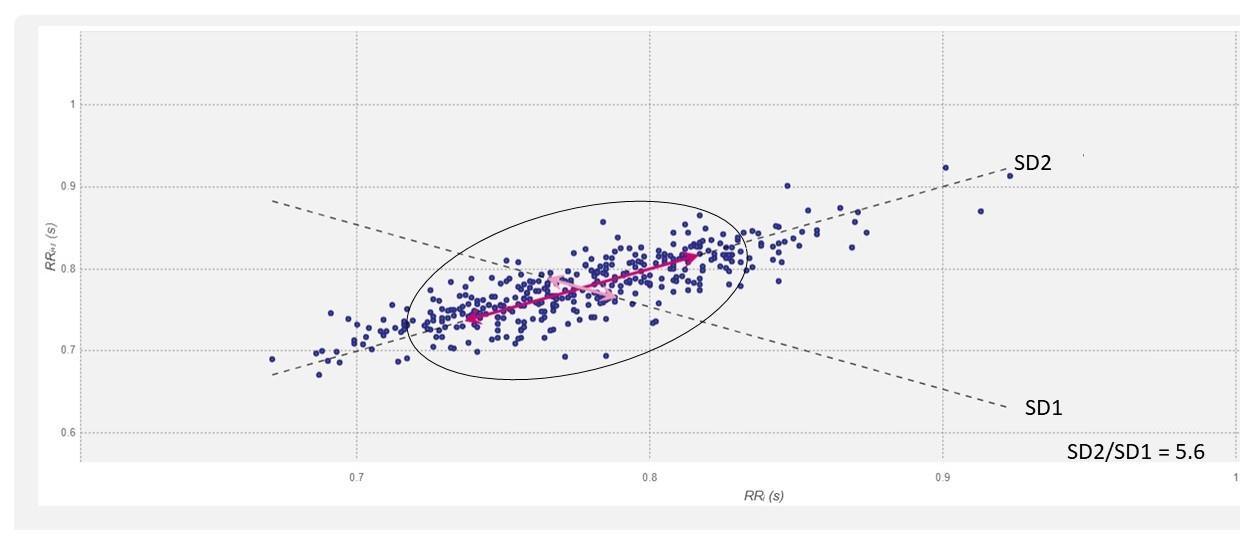
The plots in this figure are the Poincaré plots by fitting an ellipse to the scatter plotted points. The Poincaré plots help in the visual identification of the presence of non-linear HRV components. The non-linear measurements such as SD1, SD2, and S can be derived after fitting the ellipse. The standard deviation (SD) of the distance of each point from the y axis = x-axis denotes the width of the ellipse called SD1. SD1 is measured in milliseconds and correlates with the baroreflex sensitivity (28) not only in the arteries but also on the sinoatrial node or SAN (the pacemaker of the heart) (31). On the other hand, SD2 of each point from the y = x + average of the R-R interval denotes the length of the ellipse (28). SD1 denotes parasympathetic activity (increases the beat-to-beat or R-R interval), while SD2 denotes the sympathetic drive (decreases the beat-to-beat time or R-R interval). The ratio of SD2/SD1 predicts the R-R time series which in turn denotes the sympathovagal balance and correlates with low and high-frequency (LF and HF), respectively, and its ratios (HF/LF) (28) A high SD2/SD1 ratio indicates sympathetic overdrive or parasympathetic dampening or dampening of both with relatively more dampening of the parasympathetic drive. It correlates with LF/HF and has a potential influencing effect on the SAN and the electrical conducting systems of the heart. The normal SD2/SD1 value must be below 2.5 (32)
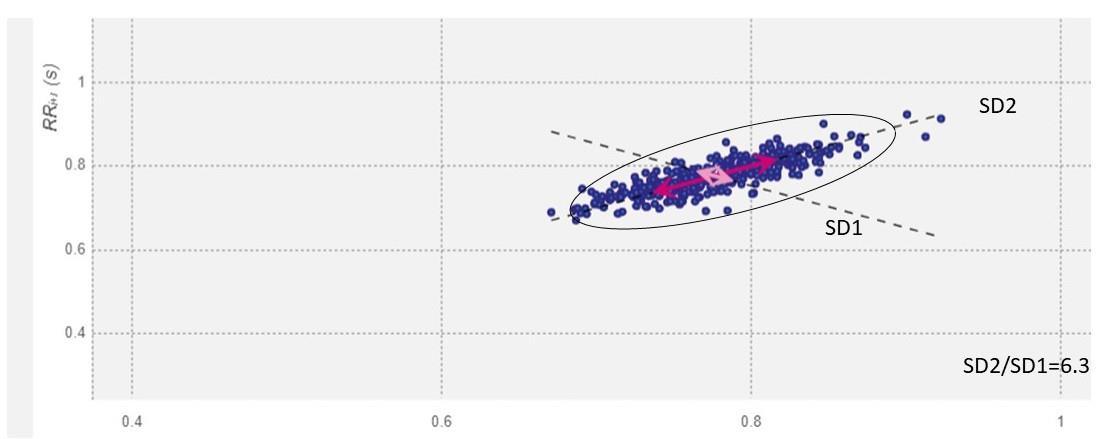
ISSN 2348-1218 (print)
International Journal of Interdisciplinary Research and Innovations ISSN 2348-1226 (online) Vol. 10, Issue 2, pp: (61-76), Month: April - June 2022, Available at: www.researchpublish.com
Table 1 showcases the important parameters of LAD, GAD-7, and HAM-A.
Table 1. Notable parameters of LAD, GAD-7, and HAM-A
Instrument Item-size Instrument type Scale Test time (min) Interpretation
HAM-A 14 Qs
GAD-7 7 Qs
LAD 1 optical biomarker
Questionnairebased selfscoring 5-point (04) 10
Questionnairebased selfscoring 4-point (03) 5
Smartphonebased optical biomarker type, based on short HRV variables
2-point (01) 5
Score <17: mild; 18-24: moderate; 25-30: severe (15)
Score >5: mild; >10: moderate; >15: severe (14)
SD2/SD1 HRV score 2.5: mild; 2.6-5: Moderate; 510: High; >10: severe (The classification is hypothetical which has been attempted to validate in this study)
A five months’ (1st July 2021 to 17th November 2021) pilot study has been conducted at Acculi Labs Pvt. Ltd. Bangalore, Karnataka India after appropriate ethical measures as mentioned above. The team size consists of eight persons – (i) the creator of the Lyfas biomarker tool (LAD) who is an electronics engineer, (ii) an experienced senior data scientist who is also a practicing clinician, (iii) three senior practicing psychiatrists who chose the GAD-7 and HAM-A instruments to test the inter-rater reliability of the LAD, interpreted the results, and managed the patients on-line who have moderate to severe GAD, (iv) two interns for pre-test and post-test general counseling and GAD-7 and HAM-A questionnaire-based data (patients’ answers) entry, and (v) one mid-career data analysts for LAD report generation for comparing to the GAD7 and HAM-A gold standard instruments. SD2/SD1 scores (LAD), GAD-7 scores, and HAM-A scores are then graded accordingly and saved as excel files for analysis. During the study, a constant touch has been maintained by the interns with all participants as per the advice of the psychiatrists.
The steps taken are as follows:
Step-1: Online advertisement and call for the study (refer to Fig 2)
Step-2: Selection of the subject with the help of the psychiatrists
Step-3: Assigning the registration number to the selected subjects
Step-4: Selection of a day of tests
Step-5: Lyfas application installation in their mobile phones and requisite training given to the subjects before the test
Step-6: Lyfas test is taken three times – before breakfast, lunch, and dinner followed by GAD-7 and HAM-A self-rating of GAD on the same day each time Lyfas tests are taken, i.e., each test is taken three times a day for each day till RTPCR is negative (average 12 days for which tests are taken)
Step-7: Lyfas analytics is performed to capture the SD2/SD1 values (consists of the LAD) and GAD-7 and HAM-A scores are also captured and evaluated simultaneously
Step-8: Data entry of LAD, GAD-7, and HAM-A is completed for further analysis, where the average values of three tests for 12 days are considered
Step-9: Validating LAD as a smartphone-based novel GAD assessing instrument using appropriate statistical methods
Step-10: Research dissemination
ISSN 2348-1218 (print)
International Journal of Interdisciplinary Research and Innovations ISSN 2348-1226 (online) Vol. 10, Issue 2, pp: (61-76), Month: April - June 2022, Available at: www.researchpublish.com
Fig. 2. Subject registration form of the anxiety study.
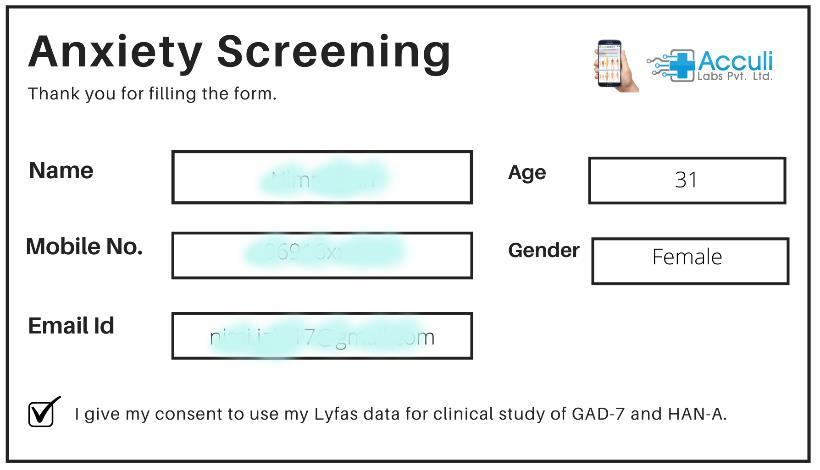
Fig. 2 shows the consent form of the participants (anonymously presented) on the company letterhead.
Analysis (age-group and gender-wise)
All experimental computations are performed using Python 3.9 on the IDLE editor (33) on Windows 10 Pro PC Following methodologies are applied to analyze the data,
Descriptive statistics (refer to Table 2) to see the basic structure of the data (34) (35)
Normality test to check data distribution whether normal or not-normal with Kolmogorov-Smirnov normality test (KST, see Table 3), where high ks-statistics (D) and low p-values refute normal distribution of the data (36) (37)
Internal consistency (Cronbach’s α) to examine the data fidelity (38) (refer to Table 4)
Spearman’s rank correlation (r statistics) analysis to test if there is any significant statistical dependence between two instruments at one time (39). In this study, the instruments are LAD vs. GAD-7 and LAD vs. HAM-A (see Table 5)
Classification metric: Sensitivity, specificity, precision, accuracy, fscore (harmonic mean of sensitivity and precision), and Youden’s index (24) to assess how good LAD can classify the grades of GAD when compared to GAD-7 and HAMA (refer to Table 6), and finally
Bland-Altman Reliability Assessment (BARA) has been performed here to examine the strength of agreement between three instruments i.e., LAD vs. GAD-7, and LAD vs. HAM-A (see Fig. 3) (40) (41), where LAD is the ‘novel’ instrument and GAD-7 and HAM-A is already two gold-standard instruments BARA works by the following calculations:
a) The mean difference between the scores of any two instruments
b) The mean values of two instruments
c) One-sample T-test
d) Mean, standard deviations, and determining the upper and lower limit with a 95% confidence interval, and finally e) The scatter graph plot
In this section, the results, obtained by the experiments are presented. Blue fonts refer to important findings.
Mean, median, and standard deviations give the structure and the spread of the data. Table 2a-c presents the descriptive statistics of LAD, GAD-7, and HAM-A of male and female test-takers. Any LAD score >2.5 refers to GAD.
ISSN 2348-1218 (print)
International Journal of Interdisciplinary Research and Innovations ISSN 2348-1226 (online) Vol. 10, Issue 2, pp: (61-76), Month: April - June 2022, Available at: www.researchpublish.com
Table 2a: LAD score (SD2/SD1 cut-off scores 2.5)
Mean Median Standard deviation Male Female Male Female Male Female 18-30 2.6492 2.7430 1.74 1.91 3.0739 3.1873 31-50 2.4331 2.4408 1.705 1.74 2.3225 2.5058 >50 2.6509 2.9542 1.76 1.57 3.2638 3.7958
Age group (years)
Table 2(b): GAD-7 score (items cumulative cut-off scores 5)
Mean Median Standard deviation Male Female Male Female Male Female 18-30 5.1052 4.3579 4 3 4.3781 3.5174 31-50 4.1970 3.5282 3 2 3.5347 3.7448 >50 5.2898 5.0937 4 3 4.1399 4.5687
Age group (years)
Table 2(c): HAM-A score (items cumulative cut-off scores >0)
Mean Median Standard deviation Male Female Male Female Male Female 18-30 9.6315 14.5909 10 12 7.8564 4.9768 31-50 10.2980 14.5698 10 12 8.5587 6.2883 >50 13.9710 16.8671 12 14.5 8.0790 6.3100
Age group (years)
Table 2a shows that on average both the genders in the age group of 18-30 years and >50 years show mild GAD. Similarly, in Table 2b, it is evident that on average males in the 18-30 years age group and both the genders over 50 years age groups present with mild GAD when scored with the GAD-7 questionnaire. In Table 2c, mild GAD is visible in both genders in all three age groups on average. Hence, on average mild anxiety has been the most predominant feature in the test population.
Normality test (KST)
Table 3: KST results
Age group (years) D p Male Female Male Female 18-30 0.2606 0.2455 0.00001 0.00001 31-50 0.2093 0.2223 0.00001 0.00001 >50 0.2191 0.2501 0.00001 0.00001
The distribution of GAD scores in both genders is not normal bell-curved with average positive skewness of 4.2387 for males and 3.8709 for females, respectively
Internal consistency (α test)
Age group (years)
Table 4: α test results
α test (LAD, GAD-7, HAM-A) Male Female
18-30 0.8606, 0.8711, 0.9082 0.8555, 0.8911, 0.9138 31-50 0.8093, 0.8923, 0.8544 0.8223, 0.9821, 0.8890 >50 0.9391, 0.9128, 0.9098 0.9501, 0.9016, 0.0385
The test confirms that the internal consistency of the data varies from ‘good’ (equals to or above 0.8) to ‘excellent’ (equals to or above 0.9) (42)
ISSN 2348-1218 (print)
International Journal of Interdisciplinary Research and Innovations ISSN 2348-1226 (online) Vol. 10, Issue 2, pp: (61-76), Month: April - June 2022, Available at: www.researchpublish.com
Now to test the statistical dependence (association strength) between LAD-GAD-7, and LAD-HAM-A, the result of Spearman’s rank correlation (r) analysis and its respective p-values has been presented below (refer to Table 5)
Table 5. ‘r’ statistics and p-values
Age group (years)
LAD vs. GAD-7 (r; p)
LAD vs. HAMA (r; p)
Female Male Female Male 18-30 0.7221; 2.24e64 0.601; 1.09e19 0.6210; 1.14e19 0.6307; 1.1e-19 31-50 0.5810; 2.33e16 0.5811; 2.1e16 0.5830; 2.40e16 0.5913; 2.3e-16 >50 0.5666; 2.25e15 0.58; 2.28e-16 0.5618; 2.75e15 0.5892; 2.38e16
From Table 5, it can be noted that GAD in the group of 18-30 years shows the highest correlations between LAD & GAD-7 and LAD & HAMA, followed by 31-50 years and above 50 years age groups. It is pertinent to place on record that LAD is statistically significant when compared to GAD7 and HAMA (p-values <0.05). further, Table 6 gives the classification metric of LAD when compared to GAD7 and HAMA
Thus, until now, the anxiety scores captured by LAD (SD1/SD2, i.e., single item), GAD-7 (7-items), and HAM-A (14items) are found to be,
Internally consistent Not normally distributed (too low p-values and small values of ks-statistics)
On average shows ‘mild’ GAD for both the genders in all age groups, and LAD has a statistically significant association with GAD-7 and HAM-A (refer to the p-values <0.05, CI 95%).
Classification metric
Table 6 presents the results, where TP, FP, TN, and FN refer to True Positive, False Positive, True Negative, and False Negative, respectively.
Table 6. Classification metric of (a) male and (b) female
MALE (N=955)
GAD-7 vs. HAM-A TP FP TN FN 760 72 99 24
Sensitivity 0.969388 Specificity 0.578947 Precision 0.913462 Accuracy 0.795812 Fscore 0.9405 Youden’s index 0.548335
FEMALE (N=499)
GAD-7 vs. HAM-A TP FP TN FN 345 30 112 12
Sensitivity 0.966387
Specificity 0.788732
Precision 0.92 Accuracy 0.691383 Fscore 0.9426 Youden’s index 0.755119
ISSN 2348-1218 (print)
International Journal of Interdisciplinary Research and Innovations ISSN 2348-1226 (online) Vol. 10, Issue 2, pp: (61-76), Month: April - June 2022, Available at: www.researchpublish.com
MALE (N=955)
LAD vs. GAD-7 LAD vs. HAM-A TP FP TN FN TP FP TN FN 800 67 73 15 750 74 103 28
Sensitivity 0.981595 0.96401
Specificity 0.521429 0.581921
Precision 0.922722 0.910194
Accuracy 0.837696 0.78534
Fscore 0.9367 0.9511 Youden’s index 0.503024 0.545931
FEMALE (N=499)
LAD vs. GAD-7 LAD vs. HAM-A TP FP TN FN TP FP TN FN 350 23 124 2 356 12 125 6
Sensitivity 0.994318 0.983425
Specificity 0.843537 0.912409 Precision 0.938338 0.967391
Accuracy 0.701403 0.713427
Fscore 0.9655 0.9753
Youden’s index 0.837856 0.895834
Table 6 presents the performance of three instruments as LAD, which is a 2-point scaled 1-item smartphone optical biomarker instrument that is aimed to be validated in this work; GAD-7 is a 4-point scaled 7-item questionnaire-based self-rating instrument, which is already a validated instrument, and HAM-A, which is a 5-point scaled 14-item questionnaire-based self-rating instrument that is already well-acclaimed incorrectly classifying GAD as mild, moderate, and severe cases (refer to Table 1) In this study, GAD-7 has been classifying cases with 79.58% and 69.13% accuracies in males and females, respectively with Youden’s indices of 0.5483 and 0.7551 in males and females. Diagnostic accuracy of 83.76% and 70.14% in males and females, respectively, when LAD is compared to GAD-7 and 78.53% and 71.34% accuracy in males and females, respectively when compared with HAM-A corroborates the fact that LAD is a reliable instrument in diagnosing GAD. The fscore values close to 1.0 corroborate the fact that there is a balance of precision and sensitivity. That is, there is a coherence of measures in the detection of: (i) individuals who are labeled positively for covidanxiety had anxiety in reality and vice versa (43). Moreover, LAD’s Youden’s index of 0.5030 and 0.8378 in males and females, respectively when compared to GAD-7 and 0.5459 in males and 0.8958 in females (when compared to HAM-A) corroborates that LAD is a reliable medical instrument that can be used in the clinical settings. It is important to note that a Youden’s index above 0.5 qualifies a novel medical instrument/device for clinical use (44) Further to state that, LAD is statistically much closer to GAD-7, where the closeness of (i) accuracy is 99.53% and 97.64% in males and females, respectively, and (ii) Youden’s index is 99.76% and 86.33%, respectively for males and females) Therefore, the study proposes that LAD can also be used in a clinical setup to screen and monitor GAD in adults.
Fig. 3(a) through 2(l) show the BARA plots for each gender and age group for a pair of instruments under the agreement test. High agreement between LAD and GAD-7 (a-f) and LAD and HAM-A (g-l) means that there is not much proportional bias in the distribution of data around the mean difference line, which can be evident in Fig.2 for both genders and all age groups
ISSN 2348-1218 (print)
International Journal of Interdisciplinary Research and Innovations ISSN 2348-1226 (online) Vol. 10, Issue 2, pp: (61-76), Month: April - June 2022, Available at: www.researchpublish.com
(a) (b) (c)
Fig.3a-c. LAD vs. GAD-7 in males (18-30 years, 31-50 years, and >50 years).
(d) (e) (f)
Fig.3d-f. LAD vs. GAD-7 in females (18-30 years, 31-50 years, and >50 years).
(g) (h) (i)
Fig.3g-i. LAD vs. HAM-A in males (18-30 years, 31-50 years, and >50 years).
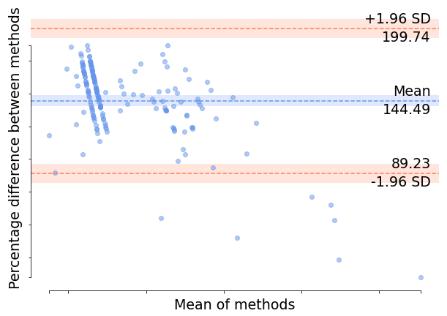

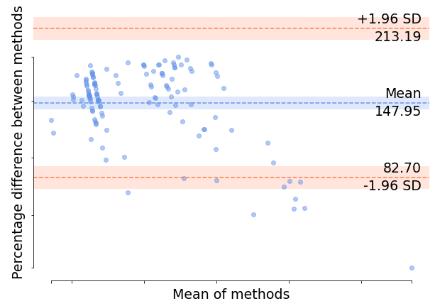
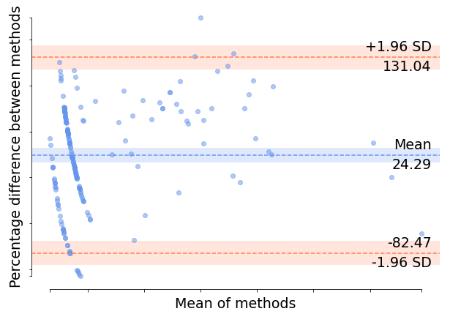
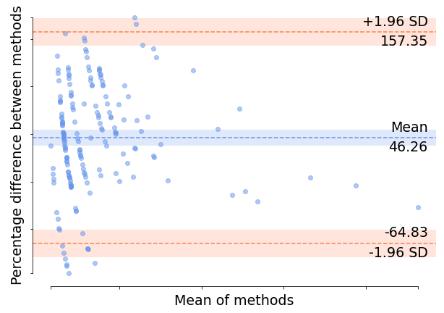
(j) (k) (l)
Fig.3j-l. LAD vs. HAM-A in females (18-30 years, 31-50 years, and >50 years).
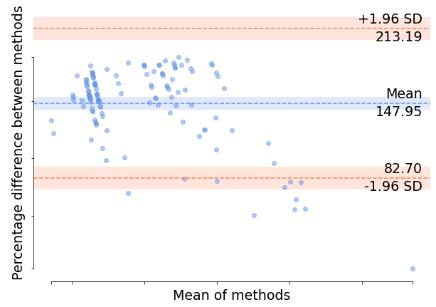
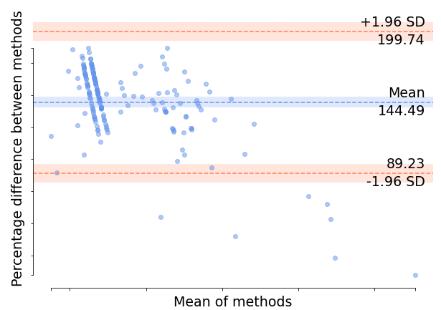
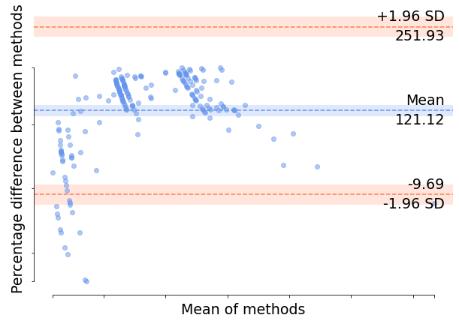
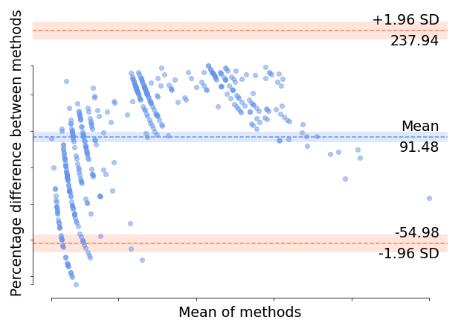
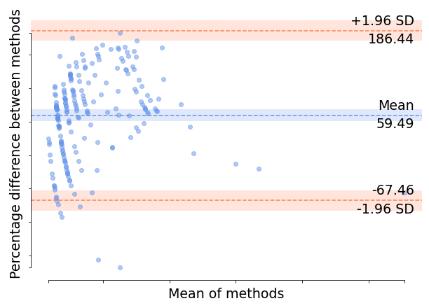
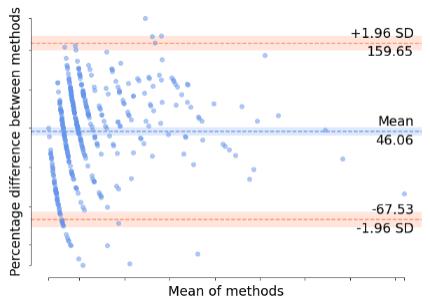
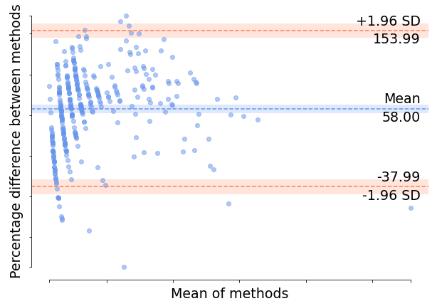
ISSN 2348-1218 (print)
International Journal of Interdisciplinary Research and Innovations ISSN 2348-1226 (online) Vol. 10, Issue 2, pp: (61-76), Month: April - June 2022, Available at: www.researchpublish.com
Fig. 3 shows the pair-wise BARA plots. In each plot, the red lines are the upper and lower bound SDs and the blue line in the middle is the mean. It is expected that the percentage difference of the methods must be around the mean to predict good inter-rater reliability. Here, the plots show high inter-rater reliabilities or less proportional bias as most of the data points lie close to the mean of methods.
Anxiety disorder is predominant these days across the globe and at a much higher grade during the COVID-19 pandemic period due to biopsychosocial disjoints across various sectors. The authors envisage that the actual load of anxiety morbidity is much larger than what is being noticed. There is evidence that persistent anxiety manifolds not only the suicide risks and vulnerabilities to substance use including alcoholism and tobacco smoking (45), but also it raises the cardiac risk, such as sudden cardiac deaths (SCD) in the vulnerable population due to uncontrolled and abnormal tachycardia (46) The key pathophysiology lies in the cascading effect of dysregulated hypothalamus-pituitary-adrenal (HPA) axis due to an uncontrollable hyperarousal from the recurrent anxiety. Uncompensated sympathetic overdrive (known as the autonomic stress or AS) could be irregularly irregular due to the randomly increased secretion of norepinephrine from the suprarenal medulla is the lead cause of unregulated tachycardia and finally, cardiac arrest where heart muscles fail to pump oxygenated blood to the brain (refer to Fig. 4) Hence, persistent anxiety must not be overlooked.
Fig. 4. The brain-HPA-AS-genetic cascade of adverse health outcomes of GAD in the population at risk. In figure 4, it can be noted that the brain is uncontrollable and susceptible to environmental stress which is targeted at the amygdala which is responsible for the fight-flight-freeze response to the stress (step 1). Amygdala stimulates the HPAaxis where the hypothalamus, under a stress situation, secretes corticotrophin which is the precursor of the adrenal corticotrophic hormone (ACTH) that the pituitary gland secretes from its ventral part (step 2a). ACTH triggers the adrenal cortex and helps synthesize and secrete the cortisol that helps meet the additional metabolic demand of the body by increasing the blood glucose level through gluconeogenesis and glycogenolysis in the liver cells. For a faster supply of glucose to the demanding cells, norepinephrine is secreted from the adrenal medulla (step 2b). Prolonged stress leads to cortisol exhaustion which plays a significant role in depression and suicidality (step 3a) Continuation of norepinephrine shooting results in sympathetic overdrive (SO), which if continues for a long time, causes fatal tachycardia and sudden cardiac death (SCD) in the vulnerable population (step 3b). it is important to note that a persistently high SD2/SD1 could be a useful marker here to predict the risk of SCD and suicide where the monoamino oxidase A (MAOA) (47) and the tryptophan hydroxylase (TPH) gene (48) dysregulation when the stress combating mechanism is lost in the GAD, as observed in the population at risk.
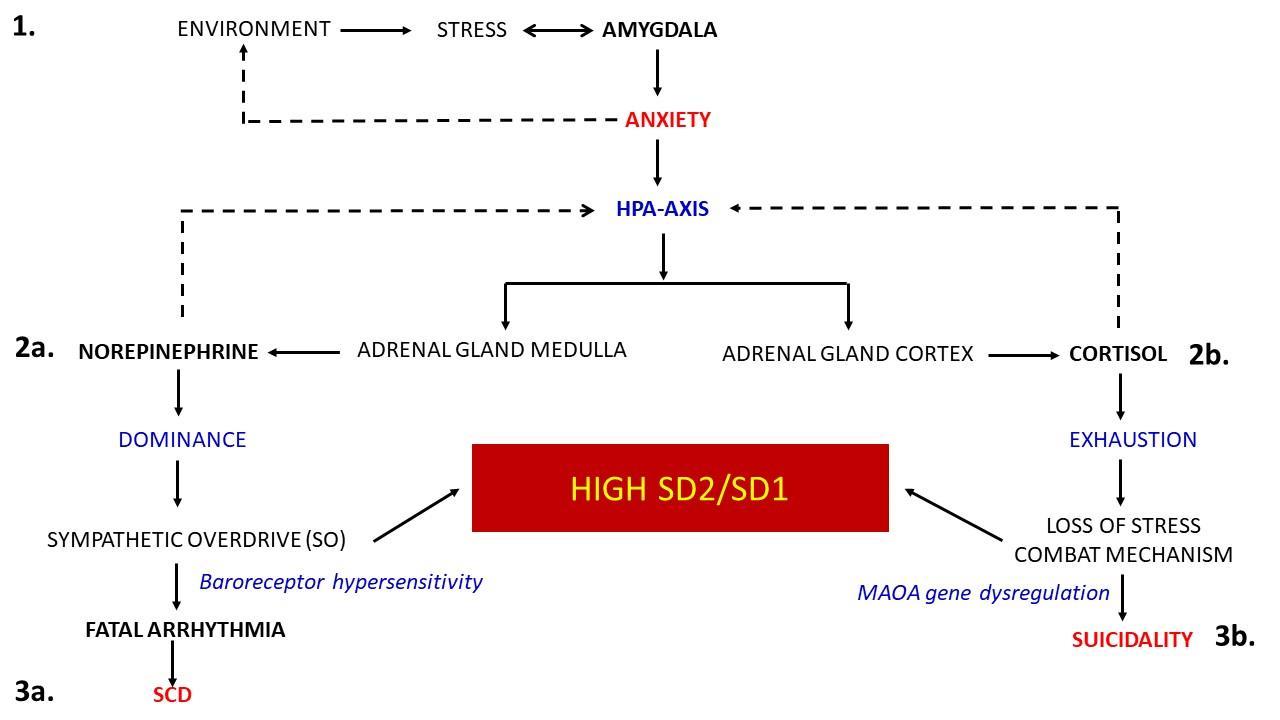
ISSN 2348-1218 (print)
International Journal of Interdisciplinary Research and Innovations ISSN 2348-1226 (online)
Vol. 10, Issue 2, pp: (61-76), Month: April - June 2022, Available at: www.researchpublish.com
The distribution of anxiety stress in India can be seen in Fig. 5 as the heatmap.
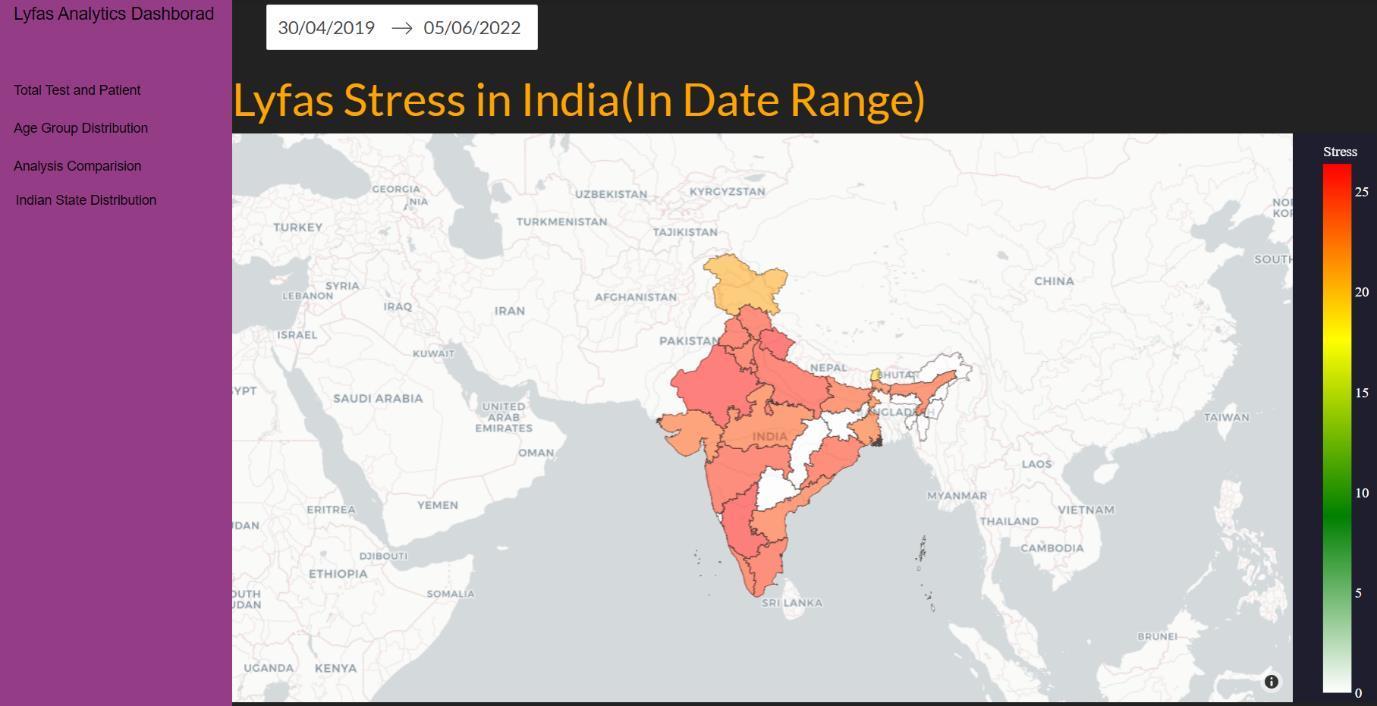
Fig. 5. The heatmap of anxiety in India.
In this figure, the heatmap is denoted by the right-sided bar where colors toward dark red indicate high scores (maximum score of 30) and colors close to white refer to low anxiety stress scores (0 as the minimum). The map shows the anxietystress situations state-wise. High stress can be seen in northern and southern states. It is important to note that the states showing white do not imply ‘0’ stress, actually the relevant data is not available in these cases
To the best of the knowledge of the authors, LAD is the only smartphone-based non-invasive and pervasive clinical instrument having a single-item optical biomarker SD1/SD2-based scale that detects GAD in adults and there is no other similar instrument reported so far. Its inter-rater reliability and agreement are high when examined against GAD-7 and HAM-A using BARA, where it is evident that there is no proportional bias in the distribution of data around the mean difference line between the novel instrument LAD and the well-acclaimed gold-standard instruments such as GAD-7 and HAM-A. Furthermore, when compared to GAD-7 and HAM-A, the average accuracy and Youden’s index of LAD are 98.6% and 93.05% in the test population, respectively although their modalities are different, which is an encouraging finding It is worth noting, therefore, that the high SD2/SD1 is a useful clue to the doctors that the test-taker has an anxiety trait, irrespective of the overt signs and symptoms, which are captured by GAD-7 and HAM-A Since an SD2/SD1 score gives the snapshots of cardiovascular autonomic modulations towards maintaining the mind-body homeostasis of the body that is reflected through the HRV and its correlates, which are altered in GAD Therefore, the advantage of LAD lies over the GAD-7 and HAM-A in terms of ‘early screening’ of the vulnerable trait of GAD in the suspected population, which is quite prevalent during the ongoing pandemic stage. Abreast the afore-mentioned advantages, the proprietorial heuristics-based diagnostic and the AI-ML algorithms have made LAD a robust instrument to capture the physiological truth at the test timestamp. In this respect, it is important to state that the questionnaire-based instruments can be manipulated by the test-takers for various interests such as social, financial, legal, professional, and so forth. Since LAD yields the physiological snapshot of the cardiovascular autonomic modulation due to the anxiety trait and the environmental threat and hence is a single biomarker-based truth-teller The snapshots of cardiovascular autonomic modulations can not be manipulated or tampered with, which poses a great advantage of using LAD over GAD-7 and HAM-A or any other questionnaire-based instruments.
There could be sampling bias due to false scoring by the subjects in GAD-7 and HAM-A questionnaire-based instruments and not divulging the intake of any anxiolytic during the selection process might have influenced the study
Moreover, the efficacy of Lyfas as an assistive healthcare instrument has been reliably validated in various clinical settings, such as (i) Duchenne Muscular Dystrophy (49), (ii) estimating the vascular aging (50), (iii) risk of heart failure in COPD patients with low FEV1 and SpO2, (26) (iv) silent depression in adults (13), (v) polycystic ovary syndrome (51),
ISSN 2348-1218 (print)
International Journal of Interdisciplinary Research and Innovations ISSN 2348-1226 (online) Vol. 10, Issue 2, pp: (61-76), Month: April - June 2022, Available at: www.researchpublish.com
(vi) the impending risk of depression in empty nest syndrome in the geriatric population (52), (vii) risk of early vascular aging in the borderline personality disorders with romantic jealousy (53), (viii) assessing the impact of hypertensionanxiety-anger triad (54), (ix) evaluating the risk of cancers with sudden high-intensity stress (55), and (x) mental health assessment during COVID-19 pandemic in the Indian adults (32). Validation of Lyfas is continuing in other healthcare fields.
Mind-heart-body is tightly interlinked. The current clinical practice is ‘specialty-based’ and that is the biggest disadvantage to the medical science itself and its stakeholders both financially and psychologically. The specialists are entrapped inside their specialty domain and usually overlook or remain uncared for other areas which also contribute to the morbidity. E.g., GAD is usually managed by a psychiatrist with anxiolytics and its consequential adverse health outcome in the body are managed by different domain specialists such as cardiologists, hepatologists, endocrinologists, and so forth. Alike other mental illnesses, GAD has several adverse health (mind-heart) consequences ranging from atrial fibrillation (56) and sudden cardiac death due to fatal ventricular arrhythmias (46) to suicides (9) due to the dysregulated autonomic homeostasis in the population at risk. Baroreceptor dysregulation plays a key role to affect the cardiovascular system as mentioned in Fig. 1 legend. Studies have also shown that people suffering from cardiac and associated mental health issues, such as severe degrees of depression, suffer from Generalized anxiety disorder GAD (7) which corroborates such intertwining from both ways.
The study concludes that SD2/SD1 can be regarded as the singleton cardiovascular optical biomarker to evaluate not only the anxiety in the population non-invasively and pervasively in a much more personalized manner but also the risk of SCD and suicide in the vulnerable population A persistently high SD2/SD1 value indicates high AS in an individual. Other associated risk factors such as tobacco smoking, substance abuse, alcoholism, sleep deprivation, added sympathetic overdrive as a result of weight training, and socioeconomic stress due to rat race competitions result in high AS and manifolds the risk of SCD and suicides.
Lyfas, being a non-invasive and pervasive smartphone instrument, can be used in a large epidemiological survey of anxiety detection. Those with persistently high SD2/SD1 scores can be assistive not only to the psychologists and psychiatrists but also to the cardiologists to save lives
Finally, the authors pay their sincere tributes to the biopsychosocial theory called ‘Dirk Hamer Syndrome’ coined by Dr. Ryke Geerd Hamer who mentioned that the brain is the key conspirator behind the occurrence of the dreaded diseases in the body (57). GAD-led SCD, other metabolic illnesses, and suicides validate his wisdom.
The authors hereby sincerely acknowledge the contribution of Yogesh Kumar Mangal of Acculi Labs Pvt. Ltd. Bangalore 560098, India for generating the heatmap of the Indian anxiety-stress heatmap.
[1] Khambaty M, Parikh RM. Cultural aspects of anxiety disorders in India.. Dialogues Clin Neurosci. 2017; 19(2): 117126. doi:10.31887/DCNS.2017.19.2/rparikh.
[2] Morris-Rosendahl DJ. Are there anxious genes? Dialogues Clin Neurosci.. 2002 ; 4(3): 251–260. doi: 10.31887/ DCNS.2002.4.3/dmrosendahl.
[3] Gottschalk MG, Domschke K. Genetics of generalized anxiety disorder and related traits.. Dialogues Clin Neurosci.. 2017; 19(2): 159-168. doi:10.31887/DCNS.2017.19.2/kdomschke.
[4] The Neurobiological Mechanisms of Generalized Anxiety Disorder and Chronic Stress. Chronic Stress (Thousand Oaks). 2017; 1: 2470547017703993. doi: 10.1177/2470547017703993.
[5] Tyrer P. Against the Stream: Generalised anxiety disorder (GAD) – a redundant diagnosis. BJPsych Bull. 2018 ; 42(2): 69–71. doi: 10.1192/bjb.2017.12.
[6] Kaur S, Maslov LN, Singh N, Jaggi AS. Dual role of T-type calcium channels in anxiety-related behavior. ournal of Basic and Clinical Physiology and Pharmacology. 2020; 31(3): 20190067. https://doi.org/10.1515/jbcpp-2019-0067.
ISSN 2348-1218 (print) International Journal of Interdisciplinary Research and Innovations ISSN 2348-1226 (online) Vol. 10, Issue 2, pp: (61-76), Month: April - June 2022, Available at: www.researchpublish.com
[7] Celano CM, Daunis DJ, Lokko HN, Campbell KA, Huffman JC. (2016). Anxiety Disorders and Cardiovascular Disease. Current psychiatry reports. ; 18(11): 101.
[8] Kintzoglanakis K, Gkousiou A, Vonta P, Sagmatopoulos A, Copanitsanou P. Depression, anxiety, and diabetesrelated distress in type 2 diabetes in primary care in Greece: Different roles for glycemic control and self-care. SAGE Open Medicine. 2022; 10: 1-9.
[9] Fisher K, Seidler ZE, King K, Oliffe JL, Robertson S, Rice SM. Men’s anxiety, why it matters, and what is needed to limit its risk for male suicide. Discov Psychol. 2022; 2(18).
[10] Dash S, Aarthy R, Mohan V. Telemedicine during COVID-19 in India a new policy and its challenges.. J Public Health Pol. 2021; 42: 501–509. https://doi.org/10.1057/s41271-021-00287-w.
[11] https://www.lyfas.com/. [Online].; 2021 [cited 2021 September 27. Available from: https://www.lyfas.com/.
[12] Cheriyedath S. Photoplethysmography (PPG). [Online].; 2019 [cited 2021 Sept 29. Available from: https://www. news-medical.net/health/Photoplethysmography-(PPG).aspx.
[13] Chattopadhyay S, Das R. Lyfas, A Smartphone-based Subclinical Depression Tracker. International Journal of Psychiatry Research. 2021;: Accepted (in press).
[14] Spitzer RL, Kroenke K, Williams JBW, Löwe B. Spitzer RL, Kroenke K, Williams JB, Löwe B. A brief measure for assessing generalized anxiety disorder: the GAD-7. A brief measure for assessing generalized anxiety disorder: the GAD-7. Arch Intern Med. 2006; 166(10): 1092-7. doi: 10.1001/archinte.166.10.1092. PMID: 16717171.
[15] Hamilton M. The assessment of anxiety states by rating.. Br J Med Psychol. 1959; 32: 50-55.
[16] Das R. Free Online Anxiety Quiz Screening Self-Assessment Mental Health Test With Clinically-Validated GAD-7. [Online].; 2022 [cited 2022 June 06. Available from: https://www.lyfas.com/test/free-online-anxiety-screening-selfassessment-mental-health-test-with-gold-standard-clinically-validated-gad-7/.
[17] Diagnostic and Statistical Manual of Mental Disorders: DSM-5. 5th ed.: American Psychiatric Association; 2013.
[18] Grupe DW, Nitschke JB. Uncertainty and Anticipation in Anxiety An integrated neurobiological and psychological perspective. Nat Rev Neurosci.. 2013 ; 14(7): 488–501. DOI: 10.1038/nrn3524.
[19] Santabárbara J, Lasheras I, Lipnicki DM, Bueno-Notivol J, Pérez-Moreno M, López-Antón R, et al. Prevalence of anxiety in the COVID-19 pandemic: An updated meta-analysis of community-based studies. Prog Neuropsychopharmacol Biol Psychiatry. 2021; 109: 110207. doi: 10.1016/j.pnpbp.2020.110207.
[20] Chattopadhyay S, Shinha P. Understanding factors impacting covid vaccination in India: A preliminary report. Quantun Journal of Medical and Health Sciences. 2021; 1(3): 18-31.
[21] Munir S, Takov V. Generalized Anxiety Disorder.. [Updated 2021 May 8]. In: StatPearls [Internet]. Treasure Island (FL): StatPearls Publishing; 2021 Jan-. Available from: https://www.ncbi.nlm.nih.gov/books/NBK441870/. 2021.
[22] Kroenke K, Spitzer RL, Williams JB, Monahan PO, Löwe B. Anxiety disorders in primary care: prevalence, impairment, comorbidity, and detection. Ann Intern Med. 2007 ; 146(5): 317-25. doi: 10.7326/0003-4819-146-5200703060-00004. PMID: 17339617.
[23] Deepa HS, Das R. EVALUATION OF NON-INVASIVE SMARTPHONE BASED DIGITAL BIOMARKER TOOL LYFAS IN DETECTING SLEEP DEFICIENCY AND ITS EFFECTS: A RETROSPECTIVE OBSERVATIONAL STUDY. Indian Journal of Applied Research. 2021; 11(1): 46-47.
[24] Chattopadhyay S, Das R. Comparing Heart Rate Variability with Polar H10 Sensor and Pulse Rate Variability with LYFAS: A Novel Study. Journal of Biomedical Engineering and Technology. 2021; 9(1): 1-9.
[25] Chattopadhyay S, Das R. A Framework for Testing the Reliability and Validity of a Novel Non-Invasive Digital Biomarker Instrument Using Statistical Techniques: A Case Study with Lyfas. Transaction in Machine Learning and Artificial Intelligence. 2022; 10(2): 1-13.
ISSN 2348-1218 (print) International Journal of Interdisciplinary Research and Innovations ISSN 2348-1226 (online) Vol. 10, Issue 2, pp: (61-76), Month: April - June 2022, Available at: www.researchpublish.com
[26] Chattopadhyay S, Das R. Statistical Validation of Cardiovascular Digital Biomarkers Towards Monitoring the Cardiac Risk in COPD: A Lyfas Case Study. Artificial Intelligence Evolution. 2022; 3(1): 1-16. https://doi.org/ 10.37256/aie.3120221252.
[27] Wenner MM. Sympathetic activation in chronic anxiety: not just at the “height” of stress. Editorial Focus on “Relative burst amplitude of muscle sympathetic nerve activity is an indicator of altered sympathetic outflow in chronic anxiety". Journal of Neurophysiology. 2018;: https://doi.org/10.1152/jn.00220.2018.
[28] Shaffer F, Ginsberg JP. An Overview of Heart Rate Variability Metrics and Norms. Frontiers in Public Health. 2017; 5: 258.
[29] Swenne CA. Baroreflex sensitivity: mechanisms and measurement.. Neth Heart J.. 2013; 21(2): 58-60. doi:10.1007/ s12471-012-0346-y.
[30] Shaffer F, McCraty R, Zerr CL. A healthy heart is not a metronome: an integrative review of the heart's anatomy and heart rate variability. Frontiers in Psychology. 2014; 5: 1040.
[31] Swenne CA. Baroreflex sensitivity: mechanisms and measurement. Netherlands heart journal Netherlands Society of Cardiology and the Netherlands Heart Foundation. 2013; 21(2): 58-60.
[32] Chattopadhyay S, Das R. Validating Lyfas as a reliable mental health screening and monitoring instrument: a step towards mobile health application during COVID-19 Pandemic. Medical Research Archives. 2022; 10(3): 1-20.
[33] [Online].; 2021 [cited 2021 December 27. Available from: www.python.org.
[34] Chattopadhyay AK, Chattopadhyay S. VIRDOCD: A VIRtual DOCtor to predict dengue fatality. Expert Systems. 2021; e12796.: 1-17. DOI: 10.1111/exsy.12796.
[35] Chattopadhyay S, Chattopadhyay AK, Aifantis EC. Predicting Case Fatality of Dengue Epidemic: Statistical Machine Learning Towards a Virtual Doctor. Journal of Nanotechnology in Diagnosis and Treatment. 2021; 7: 1024.
[36] Smirnov N. Table for estimating the goodness of fit of empirical distributions. Annals of Mathematical Statistics. 1948; 19(2): 279–281. doi:10.1214/aoms/1177730256.
[37] Kolmogorov A. Sulla determinazione empirica di una legge di distribuzione. G. Ist. Ital.. Attuari. 1933; 4: 83–91.
[38] Cronbach LJ. Coefficient alpha and the internal structure of tests. Psychometrika. 1951; 16: 297–334.
[39] Spearman C. The proof and measurement of association between two things. American Journal of Psychology. 1904; 15(1): 72–101. doi:10.2307/1412159. JSTOR 1412159.
[40] Bland JM, Altman DG. Measuring agreement in method comparison studies.. Stat Methods Med Res. 1999; 8: 135–60. 10.1191/096228099673819272.
[41] Giavarina D. Understanding Bland Altman analysis. Biochem Med (Zagreb). 2015; 25(2): 141–151.
[42] Bruin J. Introduction to SAS. UCLA: Statistical Consulting Group.. [Online].; 2006 [cited 2021 December 24. Available from: https://stats.idre.ucla.edu/sas/modules/sas-learning-moduleintroduction-to-the-features-of-sas/.
[43] Ghoneim S. [Online].; 2019 [cited 2021 December 13. Available from: https://towardsdatascience.com/accuracyrecall-precision-f-score-specificity-which-to-optimize-on-867d3f11124.
[44] McCraty M, Shaffer F. Heart rate variability: new perspectives on physiological mechanisms, assessment of selfregulatory capacity, and health risk. Glob Adv Health Med. 2015; 4(1).
[45] Nepon J, Belik SL, Bolton J, Sareen J. The relationship between anxiety disorders and suicide attempts: findings from the National Epidemiologic Survey on Alcohol and Related Conditions. Depression and anxiety. 2010; 27(9): 791–798.
[46] Batelaan NM, Seldenrijk A, van den Heuvel OA, van Balkom AJLM, Kaiser A, Reneman L, et al. Anxiety, Mental Stress, and Sudden Cardiac Arrest: Epidemiology, Possible Mechanisms and Future Research. Frontiers in psychiatry. 2022; 12: 813518.
ISSN 2348-1218 (print) International Journal of Interdisciplinary Research and Innovations ISSN 2348-1226 (online) Vol. 10, Issue 2, pp: (61-76), Month: April - June 2022, Available at: www.researchpublish.com
[47] Courtet P, Jollant F, Buresi C, Castelnau D, Mouthon D, Malafosse A. The MAOA gene may influence the means used in suicide attempts. Psychiatric Genetics. 2013; 15(3): 189-93.
[48] Abbar M, Courtet P, Bellivier F, Leboyer M, Boulenger JP, Castelhau D, et al. Suicide attempts and the tryptophan hydroxylase gene. Molecular Psychiatry. ; 6(3): 268-73.
[49] Das R, Chattopadhyay S. Towards Cardiac Risk Monitoring of Duchene Muscular Dystrophy using Lyfas. Journal of Nanotechnology in Diagnosis and Treatment. 2021; 7.
[50] Chattopadhyay S, Das R. Towards Corroborating the Arterial Stiffness with Lyfas Optical. American Journal of Biomedical Sciences. 2022; 14(1): 12-28.
[51] Chattopadhyay S, Das R. Towards Predicting Polycystic Ovary Syndrome with a Novel Smartphone-based Biomedical Application, Lyfas. American Journal of Biomedical Sciences. 2022;: Accepted, In press.
[52] Chattopadhyay S, Das R. Towards Realizing Empty Nest Syndrome using Lyfas Cardiovascular Optical Biomarkers and Power Threat Meaning Framework (PTMF) Hybrid Instrument. The International Journal of Indian Psychology. 2022; Accepted (in press).
[53] Chattopadhyay S, Das R. Modeling the Risk of Insulin Resistance in Borderline Personality Disorder with Romantic Pathological Jealousy in Females: A Lyfas Empirical Study. Open Access Research Journal of Life Sciences. 2022; accepted (in press).
[54] Chattopadhyay S, Das R. Towards Digital Phenotyping of Hypertension-Anger-Anxiety Triad using Lyfas, A Smartphone-based Non-invasive Biomarker Detecting Tool. Minerva Psychiatry. 2022; (Accepted, in press).
[55] Chattopadhyay S, Das R. Conflict, Brain, Thyroid cancer, and Lyfas: A step towards understanding the psychooncology with cardiovascular optical biomarkers. Journal of Psychiatry and Behavioral Sciences. 2022; accepted (in press).
[56] Kim H, Jeong W, Kim SH, Seo JH, Ryu JS, Kim Ys, et al. Association between social phobia and the risk of arrhythmia using the Korean National Sample Cohort: a retrospective cohort study. BMC Psychiatry. 2022; 22(39).
[57] Hamer RG. Testamento per una Nuova Medicina Germanica. IIIrd ed.: Macrolibrasi; 2006.